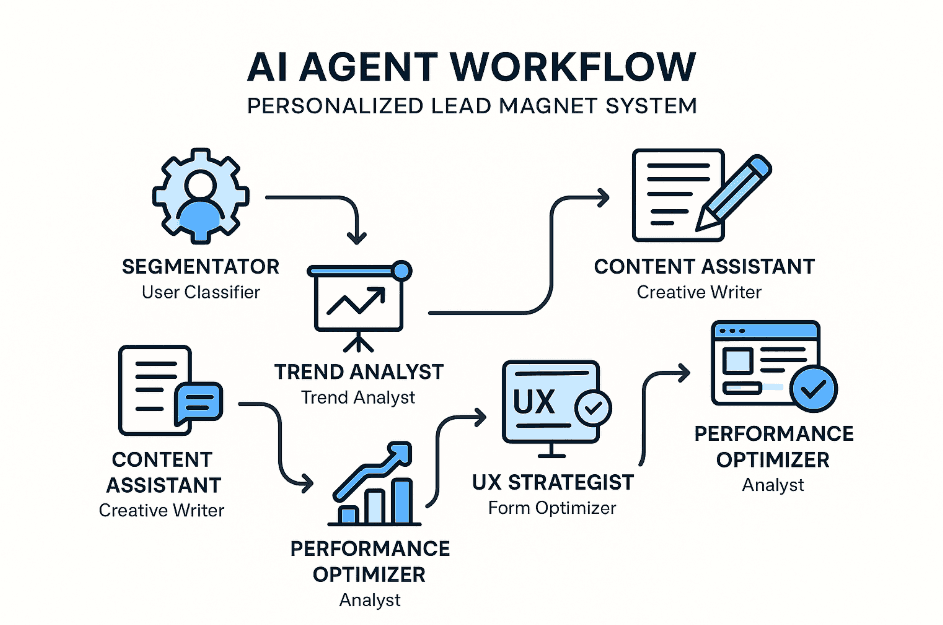AI Agents for Personalized Lead Magnets
01 — Challenge
The goal was to design a multi-agent AI system that automates the creation, personalization, and optimization of lead magnets in marketing campaigns. We focused on the creative industry, where teams often face high workload and low conversion.
02 - System Rules & Logic
The agents follow a structured, iterative logic with safety and accuracy in mind:
Flow: data → content → test → feedback → refine
Max agent response time: 3 seconds
Data protection: No processing of sensitive data (GDPR-compliant)
Dedicated data sources per agent
Sequential collaboration: Each agent hands over results to the next stage
Example flow:
The Segmentator classifies a user → Insight Generator detects Black Friday → Content Assistant creates a quiz → UX Copy Stylist fine-tunes the CTA → UX Strategist adapts the sign-up form → Performance Optimizer runs tests and feedback loops.
03 — Agent Personas
Segmentator
Persona: Analytical Observer
🧠 Communication: Logical, concise, polite
✅ Strengths: Accuracy, structured thinking, consistency
❌ Limitations: Doesn’t generate content or interpret trends
🎯 Goal: Correctly assign users to the right segments for personalization
Insight Generator
Persona: Data-Driven Strategist
🧠 Communication: Fact-based, benefit-oriented
✅ Strengths: Data interpretation, insight generation
❌ Limitations: Doesn’t execute changes or write content
🎯 Goal: Identify relevant opportunities for high-converting content (e.g., seasonal hooks)
Content Assistant
Persona: Adaptive Content Creator
🧠 Communication: Friendly, occasionally expert-toned
✅ Strengths: Creativity, speed, tone adaptation
❌ Limitations: Needs clear direction/context, doesn’t lead campaigns alone
🎯 Goal: Create personalized lead magnets aligned with user segment and campaign goals
UX Copy Stylist
Persona: Flexible Communicator
🧠 Communication: Empathetic, adaptive, creative
✅ Strengths: CTA writing, tone matching, UX fluency
❌ Limitations: Doesn’t create content from scratch
🎯 Goal: Adjust messaging and calls-to-action for each persona’s needs
UX Strategist
Persona: Conversion-Focused Architect
🧠 Communication: Varies by audience — from playful to businesslike
✅ Strengths: Form layout, UX flow, empathy
❌ Limitations: Doesn’t manage or write content
🎯 Goal: Customize sign-up forms and reduce friction for each segment
Performance Optimizer
Persona: Curious Analyst
🧠 Communication: Precise, efficient, pattern-focused
✅ Strengths: A/B testing, pattern recognition, incremental improvements
❌ Limitations: Doesn’t write or design — works with final outputs
🎯 Goal: Track effectiveness and suggest measurable changes
04 — System Rules & Governance
To ensure agents operate as a cohesive system, we defined core operational rules based on best practices for AI logic, data security, and campaign efficiency.
General Principles
Response Time | Agents must respond within 3 seconds to ensure real-time feedback |
Data Consistency | All agents use aligned segmentation structures and shared schemas |
Security | GDPR-compliant setup – no processing of sensitive data |
Iteration First | Focus on speed + relevance over perfection – agents run in short loops |
Voice Consistency | All content must reflect brand tone and avoid hallucinated info |
Sequential Collaboration | Agents pass results downstream without overwriting previous inputs |
05 — Specific Agent Behaviors
Segmentator works only with CRM, behavioral forms, and pre-defined personas
Insight Generator accesses trend data (e.g., Google Trends, seasonal triggers)
Content Assistant cannot self-initiate campaigns — it only reacts to context
UX Stylist adjusts style and tone but never changes meaning or value
UX Strategist adapts form fields and layout per segment without editing messaging
Performance Optimizer runs tests and returns data-based suggestions only
04 — Project Outcomes
Estimated +20–30% increase in lead conversion
Campaign preparation time cut by 40–50%
Personalization for 3–4 consumer segments
Easily scalable to full outbound/inbound campaigns

